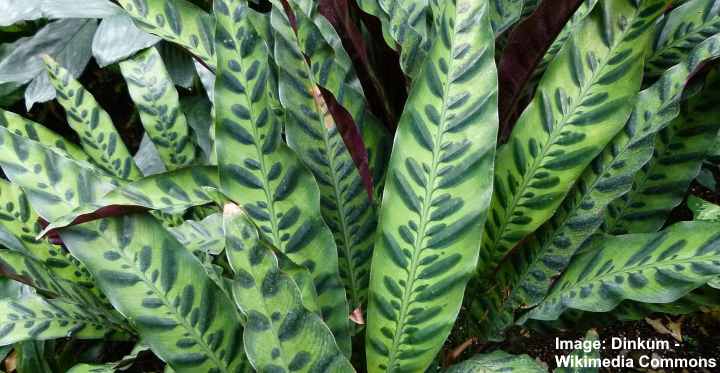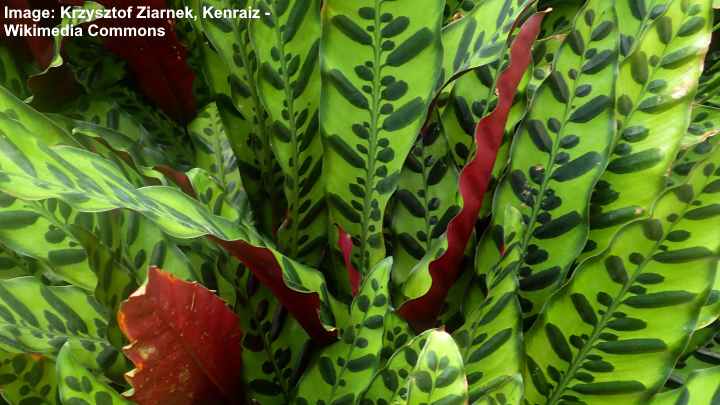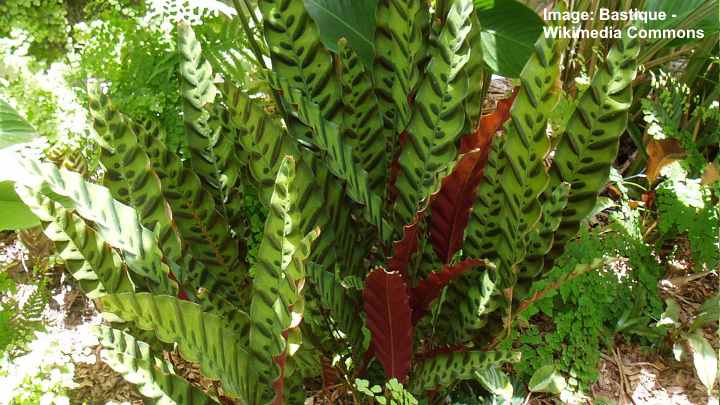Calathea Lancifolia: Care and Growing Guide for Rattlesnake Plant

Calathea lancifolia (Rattlesnake plant) is an attractive tropical houseplant with slender pointed leaves decorated with light and dark green patterns. The main attraction is its lance-shaped leaves with dark ellipse patterns on the upper side and purple colors on the underside. As an evergreen perennial, Calathea lancifolia is easy to grow indoors. The rattlesnake plant’s exotic foliage adds a touch of the tropics to any indoor décor.
The Calathea lancifolia is just one of the many species of Calathea that grow indoors. Other varieties of Calathea include the ‘pinstripe plant’ (Calathea ornata), Calathea orbifolia, and the ‘jungle velvet calathea’ (Calathea warscewiczii). From all the Calathea species, the rattlesnake plant looks most like the ‘peacock plant’ (Calathea makoyana) due to the blotchy patterns on the leaves.
This article is a complete guide to growing Calathea lancifolia at home. In addition to helpful growing tips, you’ll find solutions to many issues affecting this tropical houseplant’s growth.
How to Care for Calathea lancifolia
To care for Calathea lancifolia, grow the rattlesnake plant in bright, indirect sunlight. This calathea plant performs best planted in a porous, well-draining potting mix. Water frequently to keep the soil moist but without becoming waterlogged. Ideal temperatures are between 65°F and 75°F (18°C – 24°C), and humidity should be medium to high.
Calathea lancifolia (Rattlesnake Plant) Facts

Calathea lancifolia (Rattlesnake plant) has beautiful patterned leaves with purple-maroon undersides
Calathea lancifolia is a tropical evergreen perennial native to Brazil’s rainforests. It belongs to the plant family Marantaceae and is related to prayer plants (Maranta). In its native habitat, Calathea lancifolia grows in dappled sunlight in the warm, humid climate of rainforests.
As a tropical foliage houseplant, Calathea lancifolia grows between 24” and 30” (60 – 75 cm) tall. Its bushy, spiky appearance is made up of elongated slender lanceolate green leaves with prominent dark green markings. When the calathea leaves fold up, they reveal a beautiful burgundy-purple underside.
Calathea lancifolia is typically grown as a tropical indoor plant. Outdoors, the plant only grows in USDA zones 11 and 12. This means that you can only grow them in your garden in Hawaii or some southern areas of Florida and California.
The Calathea lancifolia gets its common name, rattlesnake plant, from the distinctive rattlesnake-like markings on the slender, wavy green leaves.
Calathea lancifolia Flowers
Calathea lancifolia is a flowering perennial that produces small yellow flowers. In its native environment, this Calathea species blooms in late spring. As a houseplant, the rattlesnake plant rarely—if ever—blooms indoors. But don’t worry, Calathea lancifolia is grown in pots for its tropical foliage, not for its flowers.
Calathea lancifolia Leaves

Calathea lancifolia narrow and long leaves have wavy margins
Calathea lancifolia leaves are slender green blades in the shape of a lance or spearhead. Leaf characteristics are dark green leaf-like patterns alternating along each side of the leaf’s center. The wavy leaf margins and purple undersides add to the tropical appeal of the rattlesnake plant.
Calathea lancifolia leaves measure up to 18” (45 cm) long.
Being a member of the family Marantaceae, Calathea lancifolia leaves share similar characteristics with prayer plants. In the evening, the pointed leaves fold together in a prayer position and then unfold in the morning.
How to Care for Calathea lancifolia
Calathea lancifolia is generally easy to care for at home. However, calathea rattlesnake plants can be fussy when it comes to light, heat, and humidity. The most crucial care requirements for this calathea plant are that the soil is kept moist and the foliage is protected from direct sunlight.
Let’s look in more detail at how to grow Calathea lancifolia indoors.
Where to Grow Calathea lancifolia
Calathea lancifolia grows best in a warm, well-lit room. You could keep it in a bright east- or west-facing room near the window that’s not in direct sunlight. Or an indoor patio or a conservatory are also suitable places to keep this heat-loving plant.
Another idea is to grow the calathea rattlesnake plant in a shaded corner of a room to add a tropical accent to a dimly-lit room. However, without plenty of bright light, the dark green patterns on the leaves may eventually disappear.
Light Requirements for Growing Calathea lancifolia
Calathea lancifolia grows best in bright light if it’s protected from direct sunlight. The sun’s intense rays can bleach the leaves, causing the calathea rattlesnake patterns to fade. You may also notice that overexposure to the sun causes brown scorch patches on the leaves to appear.
If the potted calathea plant is in direct sunshine, you should protect it behind a sheer curtain.
One sign that the Calathea lancifolia lacks light is drooping growth and faded leaves. Although most calathea plants can survive low-light conditions, their growth slows down. If you notice that the calathea stems and foliage are wilting, try moving it to a brighter location.
The Best Soil for Calathea lancifolia Plants
Calathea lancifolia thrives in loose, organically-rich potting soil with excellent drainage. The ideal soil for most calatheas is a mix of two parts peat moss and one part perlite. Sphagnum peat moss provides the calathea with nutrients and retains enough moisture to keep the roots hydrated. Amending homemade houseplant soil with perlite improves drainage.
The best soil for Calathea lancifolia plants should allow water to flow freely through the medium. However, the soil should not dry out so fast that the roots lack sufficient moisture.
The worst thing for any exotic type of calathea is soggy, waterlogged potting mix. Issues with excessive soil moisture can occur for several reasons. Here are a few reasons why calathea soil can become overly-damp:
- The potting mix is too dense, so you should amend it with peat moss and perlite.
- The calathea is rootbound, and you need to repot it.
- There are no drainage holes in the pot.
How to Water Calathea lancifolia Houseplants
Water a Calathea lancifolia often enough to keep the potting mix constantly moist during spring and summer. A useful guide for watering calatheas is to allow the top layer of soil to become almost dry. Then, drench the soil with room-temperature filtered water until it drains from the pot’s drainage holes.
In summer, you may have to water a calathea as often as once a week. During winter, a Calathea lancifolia requires less watering. Calathea growth slows down in winter, and you can water the plant when the top layer of soil is dry to touch.
Watering a Calathea lancifolia too often or infrequently stresses the houseplant. Additionally, soaking the soil repeatedly causes root rot, yellow leaves, and eventual plant death.
Temperature Requirements to Grow Calathea lancifolia
Calathea lancifolia grows well in typical room temperatures. The ideal temperature range for calatheas is between 65°F and 75°F (18°C – 24°C). For best growth, it’s vital to protect the plant from sudden temperature fluctuations. So, avoid stressing the plant by keeping it out of cold drafts and away from heating vents.
Calathea lancifolia doesn’t tolerate the cold. Its minimum temperature is 60°F (15°C). If you grow your tropical houseplants outdoors in the summer, bring them inside when the temperature drops.
Humidity for Calathea lancifolia Indoor Plants
Calathea lancifolia grows in warm, humid conditions, and typical household humidity is usually too low. Increase room humidity by putting the calathea pot on a tray with pebbles and water. Or you can use a room humidifier to increase air moisture and prevent brown foliage.
You can also mist Calathea lancifolia leaves daily. However, regularly misting calatheas is rarely enough to keep them happy—not to mention time-consuming.
As part of your regular Calathea lancifolia care routine, wipe the leaves with a damp cloth once a week. Cleaning the leaves not only keeps them looking their best, but it hydrates them and maintains healthy growth. This way, you can enjoy its leafy tropical green and purple foliage.
Calathea lancifolia Growth Rate
Calathea lancifolia has a medium growth rate when growing in bright conditions. Typically, rattlesnake plants stop growing when they reach the mature height of 2 to 3 ft. (0.6 – 1 m). In low-light conditions and during winter, growth will slow down significantly.
The Best Fertilizer for Calathea
Calathea lancifolia benefits from applying a diluted houseplant fertilizer monthly during the growing season. During spring and summer, extra nutrients help to boost growth and ensure lush, exotic foliage. The best fertilizer to use should have an NPK rating of 10-10-5.
The Calathea lancifolia rattlesnake plant is susceptible to root burn from a buildup of mineral salts. So, every two to three months, it’s a good idea to flush the soil using distilled or filtered water. Run the water through the potting mix for a minute to leach the soil of mineral salts.
Pruning Calathea lancifolia
Calathea lancifolia typically doesn’t require any pruning. The only attention you need to give the plant is to remove dying or dead leaves and stems. You can prune yellow or decaying leaves by cutting the stems at the base. Pruning dead leaves from calathea plants helps to concentrate the plant’s energy in new growth.
Repotting Calathea lancifolia
For best results, repot a Calathea lancifolia every year in spring. Carefully remove the plant from the pot, taking care not to damage the roots. Shake off excess dirt and check the roots for damage. Half fill a new pot with a soil mix for calatheas. Replant the calathea at the same height as it was before.
If your Calathea lancifolia is still growing, choose a suitable pot that is one or two sizes larger than its current one. A slightly larger container allows the roots more room to grow and prevents issues with soggy soil.
Signs that it’s time to repot a Calathea lancifolia include the following:
- Roots poking out the pot
- Water takes longer to drain
- Plant growth slows down
How to Propagate Calathea lancifolia
Calathea lancifolia propagation is best done by dividing the plant when repotting it. All you have to do is divide the roots into the number of new plants you wish to grow. Place the new plants in a pot with a suitable potting mix and water well. Put the propagated plants in a bright spot and keep the soil moist.
Is Calathea lancifolia toxic?
Calathea lancifolia is not poisonous to cats or dogs. The ASPCA puts plants in the genus Calathea on the list of non-toxic houseplants.
Pests Affecting Calathea lancifolia Growth
Calathea lancifolia is relatively resistant to common houseplant bugs, pests, and mites. Sometimes spider mites, mealybugs, or aphids could cause problems. Get rid of plant pests by applying a natural neem oil solution every seven days. Mix 2 tsp. neem oil and 1 tsp. dish soap, with a quart (1 l) of warm water. Spray the calathea leaves liberally once a week to get rid of plant bugs.
To rid a Calathea lancifolia foliage of plant pests, it’s vital to recognize the signs of these nasty critters. Here’s how to spot common calathea pests:
- Spider mites—Inspect underneath calathea foliage to look for thin silky webs. You will usually spot the webbing before seeing the white, black, tan, or red spiders.
- Mealybugs—Look for small, crawling white creatures that appear fuzzy. Mealybugs also leave a white wooly substance on plant foliage.
- Aphids—These plant-destroying insects look like tiny pear-shaped creatures on plant stems and leaves.
Usually, if you care well for your Calathea lancifolia, you’ll have few, if any, issues with pests on your tropical houseplants.
Diseases Affecting Calathea lancifolia Growth
Calathea lancifolia plants develop fungal diseases caused by excessive soil moisture. Poorly-draining soil or overwatering can cause the roots to decay, which affects the plant’s growth. The signs of calathea plant disease include leaf spot, yellowing leaves, drooping growth, and death.
The best way to prevent any fungal or bacterial diseases from affecting your plant is never to overwater it. Only water the calathea soil enough to keep it slightly moist—but never waterlogged or soggy.
Repotting the calathea with fresh potting soil once a year also helps to prevent soil compaction. Just remember to amend the potting soil with perlite, orchid bark, or gravel to improve houseplant soil drainage.
If your Calathea lancifolia shows signs of plant disease, it’s best to repot the plant with fresh potting soil. Check for any mushy brown roots and trim them before transferring to a new pot. Then, in the future, take care not to overwater or underwater your beautiful tropical calathea.
Unfortunately, if root damage is extensive, you may have to cut your losses and get a new plant.
FAQs — Calathea lancifolia Care
Although the Calathea lancifolia is generally a low-maintenance tropical houseplant, there are a few reasons why its growth could suffer.
Why are my Calathea lancifolia leaves not opening?
There can be several reasons why Calathea lancifolia leaves don’t open or fold at night. The most common ones are that the soil is too dry or there’s too much bright light. Calatheas prefer low to medium light and moist soil. To get the plant to ‘pray’ at night, try increasing humidity or moving it to a less sunny location.
Why are my Calathea lancifolia leaves drooping?
Wilting calathea leaves are typically a sign that your plant is thirsty. Check the soil for dryness and then water the plant to help revive it. It’s also important not to overwater the tropical houseplant. Additionally, cold drafts can also affect its growth.
Why are my Calathea lancifolia leaves turning yellow?
Calathea lancifolia leaves can turn yellow due to many reasons. Too much soil moisture, over-exposure to the sun, over-fertilization, or parched soil can result in yellow calathea leaves. To prevent more leaves from turning yellow, check how you care for the fussy houseplant.
It’s good to remember that old calathea leaves usually turn yellow. So, if you only have one or two yellow leaves, there is nothing to worry about. Prune the leaf stems at their base to improve your plant’s appearance.
Why do my Calathea lancifolia houseplant leaves have brown tips?
Low humidity is a common reason for Calathea lancifolia leaves developing brown, crispy tips. Try increasing humidity so that there’s more air moisture to stop calathea leaves from curling and turning brown.
Additionally, brown leaves could be a sign of mineral salt building up in the potting soil. This could be caused by over-feeding or using tap water to water plants. So, it’s a good idea to flush the soil to remove any excess minerals. To water tropical houseplants, it is usually best to use filtered or distilled water to prevent leaf browning.
How to revive a Calathea lancifolia?
To bring a Calathea lancifolia back to life, it’s vital to know why the plant is dying. If a lack of water or dry soil is causing foliage and stems to wilt, thoroughly douse the soil with water to hydrate the thirsty roots. If root rot is affecting the plant’s growth, you’ll need to repot the plant in fresh soil and remove any dead or decaying roots.
Related articles:
